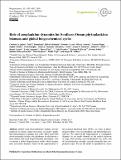Por favor, use este identificador para citar o enlazar a este item:
http://hdl.handle.net/10261/135471COMPARTIR / EXPORTAR:
 SHARE SHARE
 CORE
BASE CORE
BASE
|
|
| Visualizar otros formatos: MARC | Dublin Core | RDF | ORE | MODS | METS | DIDL | DATACITE | |

| Campo DC | Valor | Lengua/Idioma |
|---|---|---|
| dc.contributor.author | Le Quéré, Corinne | - |
| dc.contributor.author | Vallina, Sergio M. | - |
| dc.date.accessioned | 2016-08-10T12:16:42Z | - |
| dc.date.available | 2016-08-10T12:16:42Z | - |
| dc.date.issued | 2016-07 | - |
| dc.identifier | doi: 10.5194/bg-13-4111-2016 | - |
| dc.identifier | issn: 1726-4170 | - |
| dc.identifier | e-issn: 1726-4189 | - |
| dc.identifier.citation | Biogeosciences 13: 4111-4133 (2016) | - |
| dc.identifier.uri | http://hdl.handle.net/10261/135471 | - |
| dc.description | Le Quére, Corinne ... et al.-- 23 pages, 13 figures, 4 tables, supplement https://dx.doi.org/10.5194/bg-13-4111-2016-supplement | - |
| dc.description.abstract | Global ocean biogeochemistry models currently employed in climate change projections use highly simplified representations of pelagic food webs. These food webs do not necessarily include critical pathways by which ecosystems interact with ocean biogeochemistry and climate. Here we present a global biogeochemical model which incorporates ecosystem dynamics based on the representation of ten plankton functional types (PFTs): six types of phytoplankton, three types of zooplankton, and heterotrophic procaryotes. We improved the representation of zooplankton dynamics in our model through (a) the explicit inclusion of large, slow-growing macrozooplankton (e.g. krill), and (b) the introduction of trophic cascades among the three zooplankton types. We use the model to quantitatively assess the relative roles of iron vs. grazing in determining phytoplankton biomass in the Southern Ocean high-nutrient lowchlorophyll (HNLC) region during summer. When model simulations do not include macrozooplankton grazing explicitly, they systematically overestimate Southern Ocean chlorophyll biomass during the summer, even when there is no iron deposition from dust. When model simulations include a slow-growing macrozooplankton and trophic cascades among three zooplankton types, the high-chlorophyll summer bias in the Southern Ocean HNLC region largely disappears. Our model results suggest that the observed low phytoplankton biomass in the Southern Ocean during summer is primarily explained by the dynamics of the Southern Ocean zooplankton community, despite iron limitation of phytoplankton community growth rates. This result has implications for the representation of global biogeochemical cycles in models as zooplankton faecal pellets sink rapidly and partly control the carbon export to the intermediate and deep ocean | - |
| dc.description.sponsorship | C. Le Quéré and E. T. Buitenhuis were funded by UK-NERC projects NE/C516079/1 and NE/K001302/1, and European Commission project EMBRACE 282672. R. Moriarty was funded by EU FAASIS project MEST/CT/2004/514159. M. Vogt was funded by the Marie Curie Research and Training Network GREENCYCLES project MC-RTN-512464 and EUR-OCEANS project 282672 | - |
| dc.publisher | European Geosciences Union | - |
| dc.relation.isversionof | Publisher's version | - |
| dc.rights | openAccess | - |
| dc.title | Role of zooplankton dynamics for Southern Ocean phytoplankton biomass and global biogeochemical cycles | - |
| dc.type | artículo | - |
| dc.identifier.doi | 10.5194/bg-13-4111-2016 | - |
| dc.relation.publisherversion | https://dx.doi.org/10.5194/bg-13-4111-2016 | - |
| dc.date.updated | 2016-08-10T12:16:42Z | - |
| dc.description.version | Peer Reviewed | - |
| dc.language.rfc3066 | eng | - |
| dc.rights.license | https://creativecommons.org/licenses/by/3.0/legalcode | - |
| dc.contributor.funder | European Commission | - |
| dc.relation.csic | Sí | - |
| dc.identifier.funder | http://dx.doi.org/10.13039/501100000780 | es_ES |
| dc.type.coar | http://purl.org/coar/resource_type/c_6501 | es_ES |
| item.fulltext | With Fulltext | - |
| item.openairecristype | http://purl.org/coar/resource_type/c_18cf | - |
| item.cerifentitytype | Publications | - |
| item.grantfulltext | open | - |
| item.openairetype | artículo | - |
| Aparece en las colecciones: | (ICM) Artículos | |
Ficheros en este ítem:
| Fichero | Descripción | Tamaño | Formato | |
|---|---|---|---|---|
| Le_Quere_et_al_2016.pdf | 4,76 MB | Adobe PDF |  Visualizar/Abrir | |
| Le_Quere_et_al_2016_supplement.pdf | 53,52 kB | Adobe PDF |  Visualizar/Abrir | |
| Le_Quere_et_al_2016_Manual.pdf | 301,58 kB | Adobe PDF |  Visualizar/Abrir | |
| Le_Quere_et_al_2016_phytoplankton.pdf | 650,85 kB | Adobe PDF |  Visualizar/Abrir |
CORE Recommender
SCOPUSTM
Citations
81
checked on 18-abr-2024
WEB OF SCIENCETM
Citations
80
checked on 15-feb-2024
Page view(s)
230
checked on 24-abr-2024
Download(s)
545
checked on 24-abr-2024
Google ScholarTM
Check
Altmetric
Altmetric
Este item está licenciado bajo una Licencia Creative Commons

